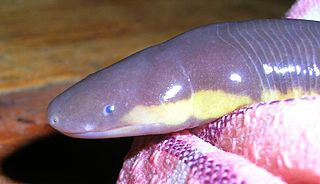 W
WIchthyophis is a genus of caecilians found in Southeast Asia, the southern Philippines, and the western Indo-Australian Archipelago.
 W
WIchthyophis bannanicus, the Banna caecilian, is a species of amphibians in the family Ichthyophiidae found in southern China and northern Vietnam, presumably also in adjacent eastern Myanmar and northern Laos. Its natural habitats are subtropical or tropical moist lowland forests, rivers, intermittent rivers, plantations, rural gardens, heavily degraded former forest, irrigated land, and seasonally flooded agricultural land. It is threatened by habitat loss.
 W
WIchthyophis beddomei is a species of caecilian in the family Ichthyophiidae. This species is distributed widely in the Western Ghats in southern India. The nominal species might be a composite of several cryptic species. It is also known as the yellow-striped caecilian, Beddome's caecilian, or Nilgherries caecilian.
 W
WIchthyophis billitonensis, the Billiton Island caecilian, is a species of amphibians in the family Ichthyophiidae endemic to the Belitung island, Indonesia. Known only from the holotype, this appears to be a small species, measuring 135 mm (5.3 in) in total length. Habitat requirements are unknown but it probably inhabits moist lowland forests. It may be threatened by habitat loss caused by opencast tin mining.
 W
WThe Bombay caecilian is an amphibian found in India. This rather large species is found in the northern Western Ghats. The eyes are distinct and surrounded by a light ring. The tentacle is placed closer to the lip than the eye. A dark brown or greyish-brown species, it has no lateral stripes.
 W
WIchthyophis davidi, the Chorla giant striped caecilian, is a new caecilian species of India discovered in Chorla, a village situated on the borders of Goa, Maharashtra, and Karnataka in the Mhadei region of India. It is one of the largest known limbless, yellow-striped caecilians from the Western Ghats. It is named in honour of David Gower, department of zoology, Natural History Museum, London, in recognition of his contributions to Indian caecilian studies. The discovery was made by researchers Gopalakrishna Bhatta of the department of biology, BASE Educational Services Private Limited, Bengaluru; K. P. Dinesh and C. Radhakrishnan of western ghats regional centre, Calicut; P. Prashanth of Agumbe Rainforest Research Station, Agumbe; and Nirmal Kulkarni of Mhadei Research Centre, Chorla Ghat.
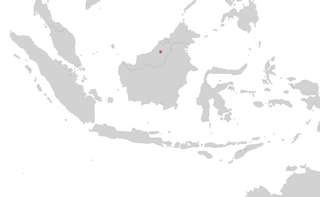 W
WIchthyophis dulitensis is a species of caecilian in the family Ichthyophiidae. It is endemic to Borneo and only known from near its type locality, Mount Dulit in northern Sarawak, Malaysia, after which it is named. Described by Edward Harrison Taylor in 1960, the holotype was collected by Charles Hose already in 1891. It is a poorly known species with uncertain taxonomic status. Common name Mount Dulit caecilian has been coined for it.
 W
WIchthyophis elongatus, the elongated caecilian, is a species of amphibians in the family Ichthyophiidae endemic to Sumatra, including some nearby islands; however, whether these belong to this species is uncertain.
 W
WIchthyophis garoensis, the Garo Hills caecilian, is a species of caecilian found in Assam and Meghalaya in north-eastern India. The Husain's caecilian Ichthyophis husaini was until 2016 considered a separate species. It is a subterranean caecilian that lives in the moist leaf-litter of tropical forests. It is typically found close to streams and other waterbodies.
 W
WIchthyophis glutinosus, the Ceylon caecilian or common yellow-banded caecilian, is a species of caecilian in the family Ichthyophiidae endemic to Sri Lanka. Its natural habitats are moist tropical and subtropical forests and pastures.
 W
WIchthyophis hypocyaneus, the bantam caecilian, is a species of amphibian in the family Ichthyophiidae of caecilians, endemic to Indonesia. Until its rediscovery in 2000, it was known only from the 1827 type specimen.
 W
WIchthyophis kodaguensis, also known as the Kodagu striped Ichthyophis, is a species of caecilian in the family Ichthyophiidae. It is endemic to the southern Western Ghats, India. All confirmed records are from southern Karnataka state, although it is also reported from adjacent Kerala.
 W
WThe Koh Tao Island caecilian, Ichthyophis kohtaoensis, is a species of amphibian in the family Ichthyophiidae found in Cambodia, Laos, Myanmar, Thailand, and Vietnam. Its natural habitats are subtropical or tropical moist lowland forests, subtropical or tropical moist montane forests, rivers, intermittent rivers, swamps, freshwater marshes, intermittent freshwater marshes, plantations, rural gardens, urban areas, heavily degraded former forests, irrigated land, and seasonally flooded agricultural land.
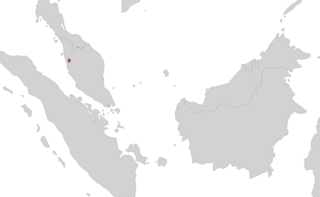 W
WIchthyophis larutensis, the Larut Hills caecilian, is a species of amphibian in the family Ichthyophiidae found in Malaysia and Thailand. Its natural habitats are subtropical or tropical moist lowland forests, subtropical or tropical moist montane forests, rivers, intermittent rivers, plantations, rural gardens, heavily degraded former forest, irrigated land, and seasonally flooded agricultural land.
 W
WIchthyophis longicephalus, the long-headed caecilian, is a species of caecilian in the family Ichthyophiidae. The body is dark violet-brown, and lighter ventrally. A yellow lateral stripe starts at the neck and reaches the tip of the tail. Small, yellow patches are also found on the sides of the neck. A midventral line formed by the breaking of annulli ventrally extends from the neck to the vent. The long head has distinct eyes, and the tentacles are close to the lip and eye. The nostrils are at the tip of the snout and visible from above. The upper jaw overhangs the lower jaw. The species is found in Kerala.
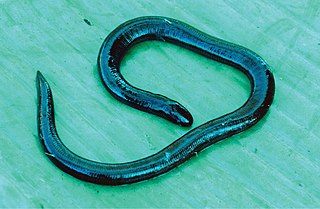 W
WIchthyophis mindanaoensis, also known as Todaya caecilian or Mindanao Island caecilian, is a species of caecilian in the family Ichthyophiidae. It is endemic to the island of Mindanao, the Philippines.
 W
WIchthyophis monochrous, the Western Borneo caecilian or black caecilian, is a species of amphibian in the family Ichthyophiidae. It is endemic to northern Borneo and known from western Kalimantan (Indonesia) and Sarawak (Malaysia), likely occurring also in Brunei. It is a little-known species known from only a few specimens. It presumably inhabits tropical moist forest. Adults are likely subterranean.
 W
WIchthyophis nguyenorum is a species of caecilian in the family Ichthyophiidae. They were first found in Kon Plông District, Kon Tum Province, central Vietnam, in 2006, and formally described in 2012. The species is now also known from the Cat Tien National Park in Đồng Nai and Lâm Đồng provinces, southern Vietnam, and is presumed to occur more widely in suitable habitat in central and southern Vietnam as well as in eastern Cambodia.
 W
WIchthyophis orthoplicatus, also known as the Pattipola caecilian or brown caecilian, is a species of caecilian endemic to Sri Lanka. It is found in a range of natural and man-made habitats including evergreen forests, rubber and tea plantations, paddy fields, rural gardens and farms, wetlands, and cattle pastureland.
 W
WIchthyophis paucisulcus, the Siantar caecilian, is a species of amphibian in the family Ichthyophiidae found in Indonesia and Singapore. Its natural habitats are subtropical or tropical moist lowland forests, subtropical or tropical swamps, rivers, intermittent rivers, plantations, rural gardens, heavily degraded former forests, seasonally flooded agricultural land, and canals and ditches.
 W
WIchthyophis pseudangularis is a species of caecilian endemic to Sri Lanka. It is found in a range of natural and man-made habitats: forests, rubber plantations, paddy fields, rural gardens and farms, wetlands, and pastureland.
 W
WIchthyophis sikkimensis, the Sikkimese caecilian or Darjeeling caecilian, is a species of caecilian found in India, Nepal and possibly Bhutan. It was described by Edward Harrison Taylor in 1960.
 W
WIchthyophis sumatranus, also known as the Sumatra caecilian, is a species of amphibian in the family Ichthyophiidae. It is endemic to Sumatra, Indonesia. It is known from western Sumatra, but many records lack precise location data and its exact range is poorly known.
 W
WIchthyophis supachaii, or Supachai's caecilian, is a species of caecilian in the family Ichthyophiidae found in Thailand's provinces of Nakhon Si Thammarat and Trang, and possibly Malaysia.
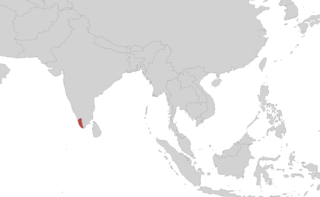 W
WIchthyophis tricolor, the three-colored caecilian or Maddatorai caecilian, is an amphibian endemic to the Western Ghats, India. Its taxonomic status is unclear, including its relationship with Ichthyophis beddomei and the possibility of cryptic species.